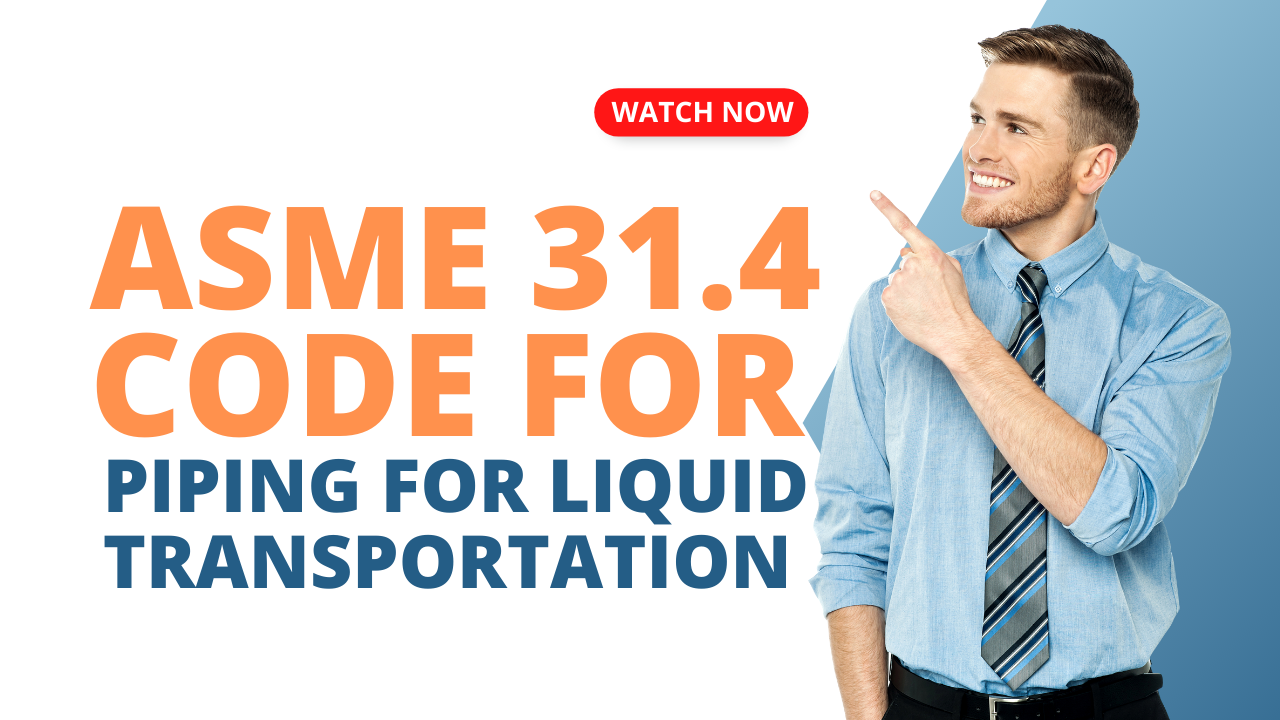Introduction
In the dynamic landscape of industrial safety and operations, adhering to standardized codes is crucial. One such cornerstone is the ASME 31.4 Code, a regulation that profoundly impacts the integrity, safety, and efficiency of fluid transportation systems. This comprehensive guide will delve into the various facets of this code, elucidating its importance, key provisions, and its role in enhancing industrial practices.
Table of Contents
ASME 31.4 Code: Defining Safety and Efficiency
The ASME 31.4 Code is a set of regulations formulated by the American Society of Mechanical Engineers (ASME). Its primary focus is on the design, construction, inspection, and maintenance of liquid hydrocarbon pipelines. Encompassing a wide array of technical specifications and guidelines, this code aims to ensure the safe and reliable transportation of fluids, mitigating risks and potential hazards.
Don’t miss the Complete Course on Piping Engineering: Check Now
By EPCLand.com
Understanding Key Provisions
Structural Integrity and Design
The ASME 31.4 Code mandates stringent design criteria to ensure the structural integrity of pipelines. It covers aspects like material selection, wall thickness calculations, and stress analysis. By adhering to these provisions, industries can avert catastrophic failures and leaks that could compromise both safety and productivity.
Corrosion Prevention and Monitoring
Corrosion is a perennial threat to pipeline integrity. The code necessitates the implementation of effective corrosion prevention measures. These encompass the use of protective coatings, cathodic protection systems, and routine inspections to detect and address potential corrosion spots promptly.
Welding and Fabrication Standards
Welding plays a pivotal role in the construction of pipelines. The code outlines meticulous welding procedures and qualification requirements. These measures guarantee the quality of welds and joints, minimizing the likelihood of defects that could lead to leakages.
Emergency Response Planning
Unforeseen events can occur despite meticulous planning. The ASME 31.4 Code requires operators to develop comprehensive emergency response plans. These plans ensure swift and coordinated actions in the event of accidents, reducing the impact on the environment and surrounding communities.
Inspection and Maintenance Regimen
Regular inspection and maintenance are imperative to ensure the longevity of pipelines. The code mandates routine assessments, non-destructive testing, and the establishment of preventive maintenance schedules. This proactive approach enhances reliability and minimizes downtime.
Enhancing Safety: Real-World Applications
Industries worldwide have reaped the benefits of embracing the ASME 31.4 Code. For instance, in the oil and gas sector, adherence to the code’s provisions has significantly reduced the frequency of accidents and spills. This not only safeguards the environment but also preserves valuable resources.
Frequently Asked Questions (FAQs)
Is the ASME 31.4 Code Applicable to Both Onshore and Offshore Pipelines?
Yes, the ASME 31.4 Code applies to both onshore and offshore liquid hydrocarbon pipelines. Its guidelines ensure the safe transportation of fluids regardless of the pipeline’s location.
How Does the Code Address Environmental Concerns?
The code mandates emergency response planning and strict inspection routines, which contribute to minimizing environmental damage in case of accidents. By preventing leaks and swift response, the code upholds environmental protection.
Can I Modify Pipeline Design as Long as Basic Standards Are Met?
While the code allows some flexibility in design, any modifications must adhere to the specified standards. Deviating from these standards could compromise safety and code compliance.
Is the ASME 31.4 Code Internationally Recognized?
Yes, the ASME 31.4 Code is widely recognized internationally. Many countries adopt similar codes or regulations based on its principles to ensure consistent safety and operational standards.
How Often Should Pipelines Be Inspected According to the Code?
The frequency of inspections varies based on factors such as pipeline age, material, and operating conditions. However, routine inspections are essential, with more frequent assessments for older pipelines or those in harsh environments.
How Does the Code Stay Updated with Technological Advancements?
The ASME periodically reviews and updates its codes to incorporate technological advancements and industry best practices. This ensures that the code remains relevant and effective in addressing emerging challenges.
Conclusion
The ASME 31.4 Code stands as a testament to the commitment to safety, efficiency, and responsible industrial practices. Its comprehensive provisions encompass various aspects of pipeline design, construction, maintenance, and emergency response. By adhering to this code, industries not only ensure compliance but also create a safer environment for their workforce, communities, and the planet as a whole.
Recommended courses (Published on EPCLand):
- Basics of Piping Engineering
- Piping Layout Engineering
- Piping Material Engineering
- Piping Stress Analysis
- Complete Course on Piping Engineering
- Material Requisitions
- Piping Material Specifications
- Valve Material Specifications
Related Video
Attempt Quiz
Question 1:
What does ASME B31.4 refer to?
Explanation: ASME B31.4 is a code published by the American Society of Mechanical Engineers that provides requirements for the design, construction, inspection, and testing of pipeline systems for liquid hydrocarbons and other liquids.
Question 2:
Which type of fluids is ASME B31.4 primarily concerned with?
Explanation: ASME B31.4 is primarily concerned with pipeline systems for transporting liquid hydrocarbons and other liquids, ensuring their safe and efficient transportation.
Question 3:
Which of the following is covered by ASME B31.4?
Explanation: ASME B31.4 covers the design, construction, operation, inspection, and testing of liquid pipeline systems used for transporting liquid hydrocarbons and other liquids.
Question 4:
What is the primary purpose of ASME B31.4?
Explanation: The primary purpose of ASME B31.4 is to ensure the safety, integrity, and reliability of liquid pipeline systems, promoting the proper design, construction, operation, inspection, and testing practices.
Question 5:
What is the typical material used for liquid pipelines regulated by ASME B31.4?
Explanation: Carbon steel is a common material used for liquid pipelines regulated by ASME B31.4 due to its strength, durability, and compatibility with various liquids.



